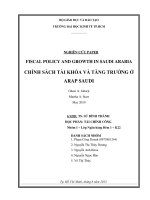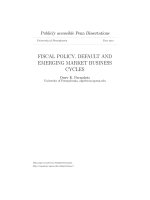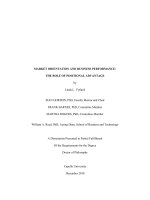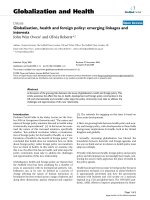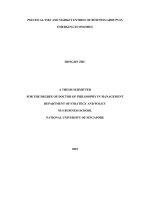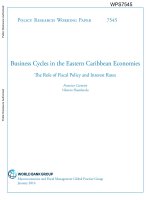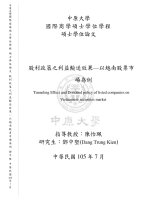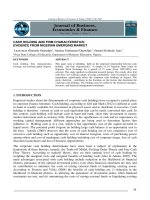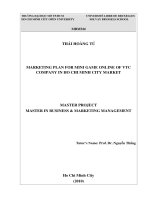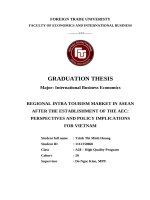Fiscal policy, default and emerging market business cycles
Bạn đang xem bản rút gọn của tài liệu. Xem và tải ngay bản đầy đủ của tài liệu tại đây (674.21 KB, 104 trang )
Publicly accessible Penn Dissertations
University of Pennsylvania Year
FISCAL POLICY, DEFAULT AND
EMERGING MARKET BUSINESS
CYCLES
Omer K. Parmaksiz
University of Pennsylvania,
This paper is posted at ScholarlyCommons.
/>FISCAL
POLICY,
DEFAULT
AND
EMERGING
MARKET
BUSINESS
CYCLES
Omer Kagan Parmakslz
A DISSERTATION
in
Economics
Presented
to
the
Faculties of
the
University
of
Pennsylvania
in
Partial
Fulfillment of
the
Requirements
for
the
Degree of Doctor of Philosophy
2010
Jose Victor Rios-Rull
Supervisor of Dissertation
UMI Number: 3447520
All rights reserved
INFORMATION TO
ALL USERS
The quality of this reproduction is dependent upon the quality of the copy submitted.
In the unlikely event that the author did not send a complete manuscript
and there are missing pages, these will be noted. Also, if material had to be removed,
a note will indicate the deletion.
UMI 3447520
Copyright 2
011
by ProQuest LLC.
All rights reserved. This edition of the work is protected against
unauthorized copying under Title 17, United States Code.
ProQuest LLC
789 East Eisenhower Parkway
P.O. Box 1346
Ann Arbor, MI 48106-1346
to Bebi¸s
ii
ACKNOWLEDGMENTS
I am indebted to Jos´e V´ıctor R´ıos-Rull for his intellectual guidance throughout
this project and my experience as a graduate student. I would also like thank Dirk
Krueger, Harold Cole and Iourii Manovskii for their valuable comments and inputs.
I thank my friends and colleagues Deniz Selman, Emily Marshall, Michaela Guleme-
tova, Shalini Roy for their support during the writing of this thesis. I am forever
grateful to my family and especially to my wife for their unconditional support and
encouragement throughout the years.
iii
ABSTRACT
FISCAL POLICY, DEFAULT AND EMERGING MARKET BUSINESS CYCLES
¨
Omer Ka˘gan Parmaksız
Jos´e V´ıctor R´ıos-Rull
Developing country fiscal policy outcomes documented in data point to stark dif-
ferences compared with developed ones. Most prominent difference is the excessive
volatility of government consumption and transfer payments and their positive corre-
lation relative to output. This seemingly non-optimal behavior is puzzling since it is
in contrast with standard theory prescriptions and likely to contribute to aggregate
volatility. To study the possible roots of this I build a model by incorporating a
detailed explicit fiscal sector to what is otherwise a standard sovereign default setup.
The environment I define is one of incomplete markets that resembles small open de-
veloping economies with respect to existence of short-maturity non-state contingent
defaultable debt as the only tradable asset for the sovereign government and financial
frictions on private sector. I use this model to identify the contribution of market
incompleteness due to the commitment problem of the sovereign. The findings point
that the endogenous state-contingent borrowing constraints that sovereigns face as a
result of commitment problem in debt repayment is a major factor in accounting for
the pro-cyclicality of transfer payments and excessive relative volatility of transfers
and government consumption in these countries. The effect of financial frictions of
the type defined as working capital constraint on an imported input combined with
debt sensitive private borrowing cost is increased volatility of fiscal policy due to debt
loosing its buffer-stock property in smoothing out shocks to fiscal revenues.
iv
Contents
Acknowledgments iii
1 Introduction 1
2 Facts and Related Literature 6
2.1 Facts . . . . . . . . . . . . . . . . . . . . . . . . . . . . . . . . . . . . 6
2.2 Related Literature . . . . . . . . . . . . . . . . . . . . . . . . . . . . 13
2.2.1 Sovereign Default and Emerging Market Business Cycles . . . 13
2.2.2 Fiscal Policy in Developing Countries . . . . . . . . . . . . . . 16
3 Fiscal Policy Volatility and Default 23
3.1 The Model . . . . . . . . . . . . . . . . . . . . . . . . . . . . . . . . . 23
3.1.1 Firms . . . . . . . . . . . . . . . . . . . . . . . . . . . . . . . 23
3.1.2 Households . . . . . . . . . . . . . . . . . . . . . . . . . . . . 24
3.1.3 Government . . . . . . . . . . . . . . . . . . . . . . . . . . . . 25
3.1.4 International Financial Intermediaries . . . . . . . . . . . . . . 31
3.1.5 Equilibrium . . . . . . . . . . . . . . . . . . . . . . . . . . . . 32
3.2 Quantitative Analysis . . . . . . . . . . . . . . . . . . . . . . . . . . . 41
3.2.1 Data . . . . . . . . . . . . . . . . . . . . . . . . . . . . . . . . 41
3.2.2 Functional forms and Calibration . . . . . . . . . . . . . . . . 44
3.2.3 Results . . . . . . . . . . . . . . . . . . . . . . . . . . . . . . . 46
v
3.2.4 Endogenous Tax Rate . . . . . . . . . . . . . . . . . . . . . . 53
3.2.5 Sensitivity Analysis . . . . . . . . . . . . . . . . . . . . . . . . 55
3.3 Conclusion . . . . . . . . . . . . . . . . . . . . . . . . . . . . . . . . . 57
4 Financial Frictions, Fiscal Policy and Aggregate Volatility 59
4.1 Introduction . . . . . . . . . . . . . . . . . . . . . . . . . . . . . . . . 59
4.2 The Model . . . . . . . . . . . . . . . . . . . . . . . . . . . . . . . . . 63
4.2.1 Firms . . . . . . . . . . . . . . . . . . . . . . . . . . . . . . . 63
4.2.2 Households . . . . . . . . . . . . . . . . . . . . . . . . . . . . 65
4.2.3 Government . . . . . . . . . . . . . . . . . . . . . . . . . . . . 66
4.2.4 International Financial Intermediaries . . . . . . . . . . . . . . 71
4.2.5 Equilibrium . . . . . . . . . . . . . . . . . . . . . . . . . . . . 73
4.3 Quantitative Analysis . . . . . . . . . . . . . . . . . . . . . . . . . . . 74
4.3.1 Data . . . . . . . . . . . . . . . . . . . . . . . . . . . . . . . . 74
4.3.2 Functional forms and Calibration . . . . . . . . . . . . . . . . 74
4.3.3 Results . . . . . . . . . . . . . . . . . . . . . . . . . . . . . . . 79
4.3.4 Conlusion . . . . . . . . . . . . . . . . . . . . . . . . . . . . . 82
5 Conclusion 83
Appendix 86
Data Sources and Coverage . . . . . . . . . . . . . . . . . . . . . . . . . . 86
Bibliography 88
vi
List of Tables
2.1 Business Cycle Moments . . . . . . . . . . . . . . . . . . . . . . . . . 6
2.2 Fiscal Facts . . . . . . . . . . . . . . . . . . . . . . . . . . . . . . . . 10
3.1 Mexican Business Cycle . . . . . . . . . . . . . . . . . . . . . . . . . 43
3.2 Benchmark Model Calibration . . . . . . . . . . . . . . . . . . . . . . 47
3.3 Benchmark Simulation Results . . . . . . . . . . . . . . . . . . . . . . 48
3.4 Endogenous Tax Simulation Results . . . . . . . . . . . . . . . . . . . 54
3.5 No Default Simulation Results . . . . . . . . . . . . . . . . . . . . . . 57
4.1 Sovereign and Corporate Interest Rates . . . . . . . . . . . . . . . . . 62
4.2 Mexico: Business Cycle Moments . . . . . . . . . . . . . . . . . . . . 75
4.3 Model Calibration . . . . . . . . . . . . . . . . . . . . . . . . . . . . . 78
4.4 Simulation Results . . . . . . . . . . . . . . . . . . . . . . . . . . . . 79
vii
List of Figures
2.1 GDP per capita vs. Relative Volatility . . . . . . . . . . . . . . . . . 11
2.2 GDP per capita vs. Output-Government Consumption Correlation . 11
3.1 Government Consumption Expenditure (NIA,IFS) vs. Government
Current Expenditure (Ministry of Finance, Mexico) . . . . . . . . . . 42
3.2 Discount Rate as a Function of Current Productivity . . . . . . . . . 49
3.3 Asset Choice as a Function of Current Productivity . . . . . . . . . . 50
3.4 Transfer Payments as a Function of Current Productivity . . . . . . . 52
3.5 Optimal Government Consumption . . . . . . . . . . . . . . . . . . . 53
4.1 Discount Rate as a function of current shock . . . . . . . . . . . . . . 80
viii
Chapter 1
Introduction
The purpose of this dissertation is to investigate and understand the dynamics and
linkage between emerging market business cycles and the conduct of fiscal policy in
these small open economies. Developing open economy business cycle dynamics differ
in many dimensions compared with their developed counterparts. While business cy-
cles in developing world seem to get smoother over the decades, developing markets
still have been experiencing rather large fluctuations. Among other work, Neumeyer
and Perri (2005) and Aguiar and Gopinath (2007) find that, on average the volatility
of output is twice, volatility of consumption relative to output and volatility of real
interest rate is roughly one and a half times more in developing economies respec-
tively. The discrepancy among these two groups of economies is not limited only to
private aggregates. Fiscal policy related aggregates as outcome of policy also seem
to behave different along the cycle across these countries. Standard theory based
normative policy prescriptions, under complete market conditions would call for a
stable discretionary government consumption spending, a-cyclical or counter-cyclical
1
tax rates and counter-cyclical transfer payments, smoothing out the provisions and
distortions created in provision of fiscal outlays. This seems to be roughly the case
in developed world, on the contrary, in developing countries, cyclical component of
government expenditures seem to be excessively volatile and their correlation with
output is and positively correlated.
1
. My work focuses on the fiscal dimension of these
differences and attempts to provide a theory that accounts for them.
In Chapter 2, I begin by providing a description and analysis of fiscal policy
aggregates and document the differences in fiscal policy actions and their outcomes
between developing and developed economies. I also briefly document the well known
facts about the business cycle properties and highlight the dissimilarities. The set of
empirical observations that point out the stark differences in terms of documented
facts between these economies will lay out the motivation for our work and provide
the structure for the quantitative exercises.
In Chapter 3, I investigate the optimal fiscal policy under the option of default for
a fiscal authority where the government is the only agent with access to international
borrowing. My contribution in this chapter is twofold. First, from an applied point
of view I add on to the existing literature by accounting for another important di-
mension of fiscal policy property akin to less developed economies, that is excessively
volatile as well as pro-cyclical fiscal aggregates. My model, calibrated to a typical
1
I use the term pro-cyclical fiscal policy to denote positive and high government consumption
and transfer expenditure-output correlation for the cyclical component.
2
emerging market economy, is able to match the pro-cyclical and volatile nature of
policy making jointly, not a question addressed in literature before to the best of my
knowledge. Second, I provide a framework in which the way government deliver fiscal
resources to the private sector potentially matter, both in terms of default incentives
and output dynamics, a point not regarded in relevant literature so far. Overall, this
chapter highlights the importance of accounting for the functional roles of different
government outlays and dynamics of the interaction of government and household
budgets investigating the spillovers from government budget constraint to private
sector.
In Chapter 4, I look into the interaction of financial frictions faced by private
and public sectors in these economies in an effort to provide a framework that would
assess the relevance of financial frictions in generating observed outcomes. Financing
frictions on firms in the form of working capital constraints has been an important
model feature in accounting for emerging market business cycle properties in the
literature. Neumeyer and Perri (2005) show that exogenous interest rate shocks that
are negatively correlated with country fundamentals combined with these wedges
does a good job replicating observed emerging market business cycles. Aguiar and
Gopinath (2006b) report similar findings and among other candidates Chang and
Fern´andez (2010)’s Bayesian encompassing model assigns a significant role in terms
of likelihood to interest rate shocks and financial frictions jointly to account for the
3
documented facts. Evidence reported from many other studies also point out the
importance of these wedges from a modeling perspective in matching the excessive
business cycle volatility (Aguiar and Gopinath, 2006b; Cicco et al., 2006, among
others).
I build a model with endogenous output and interest rate with an explicit fiscal
sector providing public consumption and transfers to households financed by income
taxation and debt issue. I introduce the financial frictions faced by the private sector
in the form of working capital constraint on an imported factor of production. The
firms’ financing costs for borrowing against this constraint is set as a consequence
of government borrowing, that is both public and private sectors face the same bor-
rowing rate determined by government indebtness. In such an environment, we have
a dynamic interaction between government’s willingness to use debt for public good
provision and alleviation of tax distortions, and output. This feature of our model
that generate an financial linkage between and distortionary government policy and
private sectors does not exist in existing literature. The interaction works from fiscal
authorities actions and constraints to factor prices and tax rate private sector face
and becomes a source of disturbance on private sector. In particular, difficulties in
government’s budget constraint, translate into financing difficulties for private sector
that has a negative effect on output. The evidence do support such linkages exist
not just in times of severe crises but throughout normal times as well in developing
4
countries (Mendoza and Yue, 2008). To quantitatively asses the importance of this
margin, we calibrate basic parameters of our model economy to standard values from
the literature when available and estimate a set of them to match certain fiscal policy
and aggregate statistics of interest for a typical emerging market economy, Mexico.
To measure the contribution of financial frictions, we do a sensitivity analysis of dif-
ferent degrees of parameter controlling friction level, θ on the firms to measure the
effect of this margin on behavior of variables of interest. My contribution in this
chapter is to provide a framework that highlights this channel in emerging market
business cycles and investigate its empirical importance in accounting for the joint
excessive volatility of public and private spheres that seems to be a robust feature of
these countries.
5
Chapter 2
Facts and Related Literature
2.1 Facts
The real business cycle literature on small open economies dates back to Mendoza
(1991). In that work, Mendoza investigates the ability of a standard real business
cycle model with small alterations, calibrated to Canada, in replicating the observed
facts. His findings was that to a great extent it did. This however was not to say
the standard model was a success in accounting for business cycles in all small open
economies.
Table 2.1: Business Cycle Moments
Statistic Developing Developed
σ(y) 2.74 1.34
σ(c)
σ(y)
1.45 0.94
σ(r) 2.32 1.66
ρ(r, y) -0.55 0.20
Source: Aguiar and Gopinath (2007)
6
As briefly mentioned in Chapter 1 and Table 2.1 clearly shows
2
, the observed char-
acteristics of a large class of such economies, namely emerging markets, exhibited very
different characteristics than developed ones . The most particular characteristics of
these economies that caught attention of researchers was the excess volatility com-
bined with a strong relation between interest rates and output that contradicted the
insignificant role of interest rates in earlier models of standard business cycles in small
open economies (see Mendoza (1991), and Correia et al. (1995)). These earlier mod-
els, as they were defined, lacked the possibility of explaining a fact most emerging
market economies had to live with, which is frequent and significant fluctuations in
their cost of financing on external borrowing in international markets and its counter-
cyclical nature with their output. For these countries with relatively less developed
financial systems and inadequate national saving, external borrowing was and still is
an important source of finance for growth. Also excess macroeconomic volatility and
considering most of them are in an transitional growth path, access to international
borrowing is crucial for consumption smoothing as well. Experience show that trou-
ble for these countries in international financial markets, which appears as capital
outflow, usually have real effects. Considerable amount of study has been done on
the area to understand the causes, consequences and dynamics of this relationship.
2
Sample for table 2.1: Developing ; Argentina, Brazil, Ecuador, Israel, Korea, Malaysia, Mexico,
Peru, Philippines, Slovak Republic, South Africa, Thailand, Turkey. Developed; Australia, Austria,
Belgium, Canada, Denmark, Finland, Netherlands, New Zealand, Norway, Portugal, Spain, Sweden,
Switzerland.
7
The discrepancy among these two groups of economies is not limited only to
private aggregates. Fiscal policy related aggregates also seem to behave differently
along the cycle across these countries. Gavin and Perotti (1997) was the first one
to document and point out these stark differences for Latin American countries. He
found out that each component of fiscal layouts was substantially more volatile for
the Latin American countries compared with industrialized ones, with the biggest
difference being in government consumption and transfer payments. Talvi and V´egh
(2005) extended these findings in showing that these observations are not only a
feature of Latin American countries but also a common thing among developing
economies.
Standard normative policy prescriptions would call for a stable discretionary gov-
ernment consumption spending and a-cyclical or counter-cyclical tax rates that would
generate a primary fiscal surplus that is somewhat pro-cyclical, smoothing out the
provisions and distortions created in conduct of fiscal policy. As summarized in Ta-
ble 2.2, this seems roughly to be the case in developed world. On the contrary in
developing countries, cyclical component of discretionary government consumption
and transfer payments are extremely volatile and their response to output seems to
be strong, such that resulting primary fiscal surpluses that are not pro-cyclical. Per-
haps, what is more striking to observe is as a form of an insurance by the public
sector provided to households, one would expect especially the transfer payments to
8
be counter-cyclical in response to output fluctuations yet this does not seem to be
the case for developing world. Transfer payments fluctuates very strongly and seem
to follow the pattern of output over time. Suzuki (2010) for a subset of countries
reports the volatility ratio of transfer payments to output in developing world in is
twice as much in developing world compared with OECD average (2.86 vs. 4.27)
and average correlation with output is significantly different ( 18 vs. .20). For the
period 1960-2005
3
with annual data, grouping set of 55 countries according per-capita
income, we find for the countries below the 60% of highest possible per-capita income
(32 countries) the median ratio of government consumption-output volatility is 2.12
and correlation with output is 0.42 whereas for the developed ones (23 countries) the
same statistics are 1.55 and 0.12 respectively. The behavior of primary fiscal sur-
pluses also reflects the differences in as an outcome of fiscal policy conduct. For the
period of 1988-2001 for 12 OECD countries, I find the average correlation of primary
surplus with output is 0.61 as standard optimal policy would suggest. For a sample
of 19 developing economies with a varying length of data availability on annual ba-
sis between 1970-2001, same statistic is only 0.04 for a set of developing countries.
Furthermore, behavior of transfer payments for the two sets of economies differ as
well. Talvi and V´egh (2005) also find for the period of 1970-94, the correlation of
government consumption with output for a set of 20 industrialized countries is 0.17
3
With varying individual country data periods.
9
(-0.02 for the subset of G7) and 0.53 for a set of 36 developing countries. Riascos
and V´egh (2003) report using annual data, in a sample of 16 developing countries, on
average government consumption is 3.22 more volatile than output, whereas this ratio
is 1.54 in their developed counterparts. Catao and Sutton (2002),Manesse (2006) and
Kaminsky et al. (2004a) report similar results, for different time periods for different
subset of countries grouped by their per-capita income level, that point out the same
significant difference. Finally, Ilzetzki and Vegh (2008) using an extensive dataset and
applying several econometric tests confirm that a developing economy fiscal policies
are indeed very procyclical.
Table 2.2: Fiscal Facts
Statistic Developing Developed
σ(g) 3.90 1.83
σ(g)/σ(y) 2.12 1.55
σ(T )/σ(y) 4.27 2.86
ρ(g, y) 0.42 0.12
ρ(ps, y) 0.04 0.61
ρ(T, y) 0.20 -0.18
Source: See Appendix A for data sources and coverage
From the revenue side concerning the tax rates, availability of data is limiting
factor for conclusive statements on their cyclical behavior. Kaminsky et al. (2004b)
report a negative correlation with output for inflation tax for the non-OECD countries
10
3
3.5
4
4.5
5
d
(y)
GDPPerCapitavs.std(g)/std(y)
0
0.5
1
1.5
2
2.5
0 0.2 0.4 0.6 0.8 1 1.2
std(g)/st
d
GDPpercapitarelativetoUSA
Figure 2.1: GDP per capita vs. Relative Volatility
1.2
GDPpercapitavs.Corr(g ,y)
1
0.8
t
oUSA
0.6
apitarel.
t
0.4
GDPperc
0
0.2
0
‐0.4 ‐0.2 0 0.2 0.4 0.6 0.8 1 1.2
Corr(g,y)
Figure 2.2: GDP per capita vs. Output-Government Consumption Correlation
11
in their sample, whereas it was positive for OECD members. Mailhos and Sosa (2000)
finds for the case of Uruguay between the years 1975-1999 all relevant tax rates were
procyclical. Talvi and V´egh (2005) provides anecdotal evidence on how both Mexico
and Argentina raised taxes to increase revenues in the midst of the crises, furthermore,
fiscal austerity programs that involve tax hikes is not an uncommon phenomenon in
case of crises for these countries. This again, is in contradiction with orthodox optimal
taxation prescriptions.
We know from standard theory of insurance contracts higher risk faced in terms
of higher volatility would make access to credit more valuable for the need of con-
sumption smoothing yet Catao and Sutton (2002), in a study on the emerging market
international borrowing, show that higher volatility implies lower credit ratings and
higher borrowing costs in international markets. From this perspective, regarding the
policy induced volatility due to pro-cyclicality of fiscal expenditures standard theory
would imply, existing policy making choices seem irrational for these country govern-
ments. Understanding the underlying causes of this puzzling behavior is important
and is the source of motivation for this study.
12
2.2 Related Literature
The theoretical part of my research is based on the sovereign default literature that
dates back to the work of Eaton and Gersovitz (1981) and the motivation, as men-
tioned, comes from another literature that focus on fiscal policy peculiarities of devel-
oping world. In next two sections, I will briefly cover these recent research agendas to
the extent of their connection to my work and identify the place of my work within
these two strands of literature. I begin by briefly covering the emerging market busi-
ness cycle research that flourished recently and have began to utilize the link between
sovereign default and business cycle volatility. Then I cover the literature on fiscal
policy properties and differences of developing world and research that attempted to
provide explanations for them.
2.2.1 Sovereign Default and Emerging Market Business Cy-
cles
The strand of literature that focused on private sector aggregates of emerging markets
began with treating the real interest rate movements as exogenous shocks and the
driving force of fluctuations in emerging markets (see Neumeyer and Perri (2005),
Aguiar and Gopinath (2006b) and Kanczuk (2004) among others). Combining an in-
terest rate wedge that is working on production with exogenous interest rate shocks,
output volatility is amplified and models of this sort are able to explain a considerable
13
share of excess volatility of output and counter-cyclicality of interest rates. Modeling
interest rates exogenous, or their relation to country fundamentals ad-hoc at best,
could be seen as a shortcoming of this approach. Interest rate combined with pro-
ductivity shocks partially succeeded in explaining business cycle fluctuations in these
economies.
Another branch of recent literature focuses on explaining the volatility of interest
rates paid by these countries, taking their excessively volatile output realizations as
given (see Arellano (2008), Yue (2009) and Aguiar and Gopinath (2006a) among
others). The basic idea, based on seminal work of Eaton and Gersovitz (1981) and
on analysis on unsecured consumer default by Chatterjee et al. (2007), combines
default incentives of the sovereigns with their finance costs. In these set of studies,
the fluctuations in output is transmitted to fluctuations in risk premium the country
has to pay, which makes the real interest rate, composed of risk free rate plus the risk
premium, volatile. The link between output realizations and interest rate is based
on lack of the emerging market sovereign’s ability to commit to pay back the loans
taken. This inability makes sovereign behave in an opportunistic way, paying back
if and only if doing so makes sovereign better of than defaulting. Unlike an usual
insurance contract, these models was able to generate higher incentives for default
when the output realization is low, thus fluctuations in output is mirrored in real
interest rate through default incentives and counter-cyclical dynamics. In these set of
14
